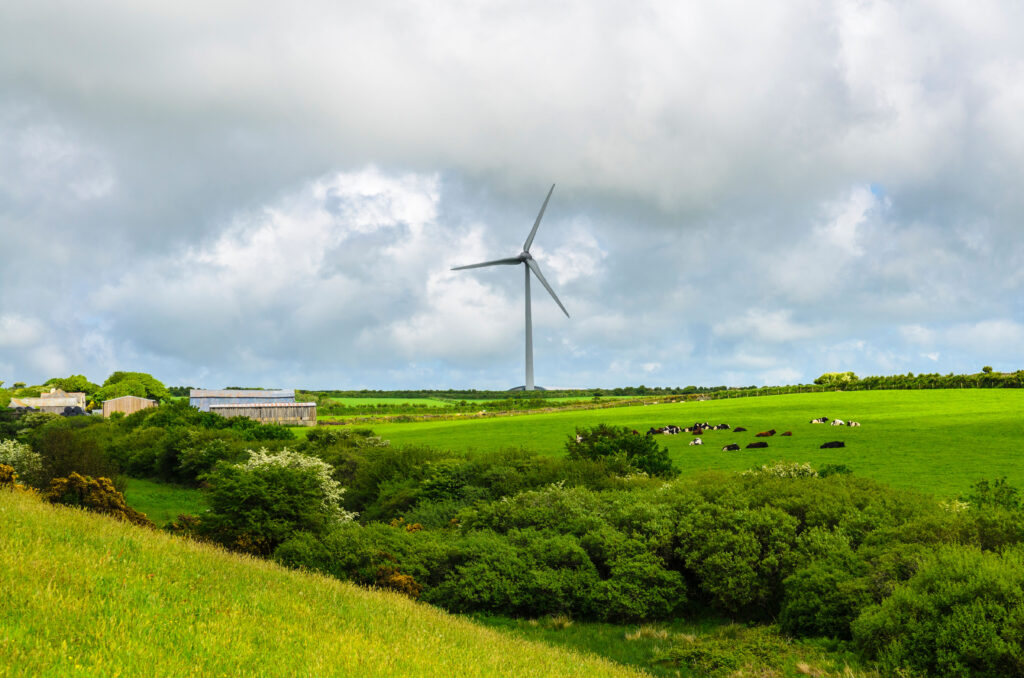The allure of wind energy has stood the test of time, captivating human innovation for millennia. From the graceful sails of ancient ships to the iconic blades of windmills that ground grains, wind’s potential is undeniable.
How do modern wind turbines work?
Modern wind energy harnesses the kinetic force (movement) of air to generate electricity, propelling us into a cleaner and more sustainable future.
In modern wind turbines wind rotates the rotor blades, converting kinetic (motion) energy into rotational energy. This rotational energy is transferred by a shaft to the generator, thereby producing electrical energy1.
What are the challenges of wind energy?
In recent years as wind farms have become more prevalent across the landscape, developers have faced challenges from local communities who do not like the look, or sound, of them. Developers need to work with local communities to ensure that they receive the benefits of renewable energy infrastructure and do not feel ignored or overlooked. However, the ideal sites for wind farms are often located in remote locations, meaning that larger wind farms are often not in close proximity to highly populated areas and therefore have less impact on local populations.
Conservationists have also been concerned at the potential impact of wind turbines on wildlife, especially migrating birds and marine wildlife that depend on sound to navigate and communicate. Developers need to consider factors such as known bird migration routes when planning new installations, and taking measures to reduce the disruption to other wildlife habitats when construction is taking place. As technology improves, less obstructive, quieter, wind turbines will also hopefully address some of these issues.
Wind energy is also weather dependent, for this reason we cannot be dependent on one source of energy alone. Wind energy can be deployed alongside other forms of renewable energy, such as solar, and carefully managed to ensure a consistent supply to the grid.
Finally, compared to some other sources of renewable energy wind has higher build and maintenance costs. This is in part because wind turbines have a very long useful life, meaning that the upfront costs deliver a long period of energy return. The UK’s oldest commercial windfarm, Delabole in Cornwall, was constructed in 1991 and is still producing electricity today. Continued technological developments are also contributing to reducing maintenance costs over time.

What are the opportunities?
In order to meet the Paris Goals to limit global warming, and subsequent climate change, the world needs to transition to lower carbon emitting sources of energy. Wind energy is a renewable, clean, source of energy that can be utilised almost anywhere the wind blows and as such will play a key role in this energy transition.
A single wind turbine does not take up a large amount of land, and they can be effectively installed as single units, meaning that they can be easily integrated into agricultural and other multi-use landscapes without limiting the availability of land for other uses.
Whilst historically quite expensive, given the upfront cost of installation and the maintenance required for large moving parts, advances in technology are addressing this, and energy from wind is now cheaper than energy from coal2. In the last decade the cost of onshore wind has fallen almost 56% and offshore wind by almost 48%3.

Energy from wind power will play a key role in the renewable energy mix of the future, unlike solar it is not dependent on hours of daylight and so is of vital importance to economies in higher latitudes to contribute to a steady flow of energy into the grid – especially during working, but dark, hours in the winter months.
A recent report from the Energy Transitions Commission estimated that investment in the net-zero transition needs to increase from the current £800 billion to £2.4 trillion per year to meet global decarbonization targets by 2050 4. Approximately a third of all energy globally will need to come from wind in a scenario where global energy is fully renewable by 20505, requiring a significant portion of this investment. Closing this funding gap will be a challenge for governments, meaning that there is a significant opportunity for the private sector to support the energy transition.
Get in touch to learn more about how Bluefield companies advise on investing in, managing, operating and developing renewable wind energy.
Bluefield, powering a sustainable future.
[1] Wind energy (n.d.) IRENA. Available at: https://www.irena.org/Energy-Transition/Technology/Wind-energy
[2] Solar power got cheaper, so why aren’t we using it more? (2021) Chrobak, U.Available at: https://www.popsci.com/story/environment/cheap-renewable-energy-vs-fossil-fuels/
[3] Most new wind and solar projects will be cheaper than coal, (2021) Ambrose, J. Available at: https://www.theguardian.com/environment/2021/jun/23/most-new-wind-solar-projects-cheaper-than-coal-report
[4] Financing the net-zero transition: meeting the $3.5 trn challenge (2023) Forsdick, S.Available at: https://www.raconteur.net/climate-crisis/financing-net-zero-transition
[5] Energy Transition Outlook 2022 (2022) DNV. Available at: https://www.dnv.com/energy-transition-outlook/download.html


